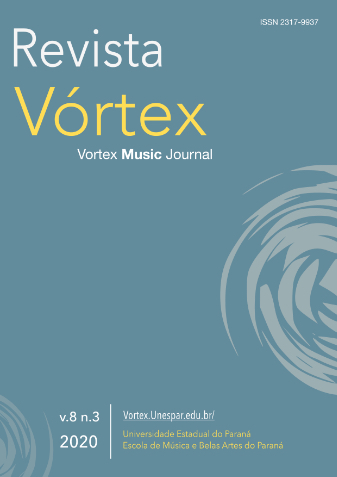The Guitar as a Laboratory for Experimentation
DOI:
https://doi.org/10.33871/23179937.2020.8.3.1.10Palavras-chave:
electric guitar, prepared instruments, extended techniques, notation, compositional techniquesResumo
In this article, I will discuss the role of the electric guitar in the conception, development and composition of three recent works: Recessional Motion, Flexidra IV, and Volpi/Formentera. In Recessional Motion, I will address compositional, technical and notational issues to explain the underlying creative process. In Flexidra IV, all the pre-compositional materials were the result of extensive experimentation sessions with electric guitars, pedals and found objects that subsequently were extrapolated to other instruments to generate the instrumental textures. In Volpi/Formentera, the electric guitar is at the centre of the compositional processes and all the musical parameters orbit around it. I will examine in detail how the different preparations and instrumental textures were derived from my own "˜exploratory sessions' presenting possible solutions to notate the necessary actions to produce the sounds in the guitar.Downloads
Referências
ACOSTA, Rodolfo. Archipiélagos de la Esperanza para viola y violonchelo. Bogotá: Matiz Rangel editores, 2006. Score.
ALBERMAN, David. Abnormal Playing Techniques in the String Quartets of Helmut
Lachenmann. Contemporary Music Review. London, Vol. 24, No. 1, p. 39 – 51, 2005.
CHILDERS, Tim. Vera Rubin: The Astronomer Who Brought Dark Matter to Light, Space, June 11 2019. Available at https://www.space.com/vera-rubin.html. Accessed on 6 Aug. 2020.
GARCíA, Marcela. Estructuralismo y tendencias posmodernas en la obra "Diálogo en simetrías móviles" para piano preparado y clavicémbalo de la compositora contemporánea colombiana Catalina Peralta, Revista A Contratiempo, No. 13, 2009.
HUBBLE, Edwin. The Realm of Nebulae. New York: Dover Publications, 1953.
KAKA, Askander. Calculation Methods of the Length, Area and Volume of Iterated Function System Fractals. Journal of Koya University. No. 26, p. 149 – 158, 2013.
LEYVA, Camilo, et al. Feliza Bursztyn: Elogio de la Chatarra. Bogotá: Museo Nacional de Colombia, 2009.
MENDEZ, Camilo. Texts, Numerical Sequences and Patterns in my Recent Music. 2016.
Thesis (Doctoral, Music composition). Royal College of Music, London.
MENDEZ, Camilo. Fragmentos Cardinales V: Recessional Motion. Self-published, 2013. Score.
MENDEZ, Camilo. BURSZTYN VII: Flexidra IV. Self-published. 2015. Score.
MENDEZ, Camilo. Archipelago Sierpinski: Volpi/Formentera. Self-published. 2017. Score.
McDANIEL TARVER, Gina. The Art of Feliza Bursztyn: Confronting Cultural Hegemony, Artelogie, No 5, p. 1 – 20, 2013. Available at http://cral.in2p3.fr/artelogie/spip.php?article273. Accessed on 30 jul. 2020.
NOGUERA, Carolina. Quattuor Verba para cuarteto de cuerdas. Bogotá: self-published, 2006. Score.
PANEK, Richard. The 4% Universe. Oxford: Oneworld Publications, 2011.
PARASKEVAíDIS, Graciela. Doce móviles de Jacqueline Nova: una aproximación analítica. Bogotá: Latinoamérica Música, 2000. Available at http://www.latinoamerica-musica.net/obras/nova/moviles.html. Accessed on: 3 aug. 2019.
PERALTA, Catalina. Diálogo en Simetrias Móviles para clavicémbalo y piano. Revista A Contratiempo No. 13, 2009. Score.
RECER, Paul. Phantoms in the Machine of Universe. Los Angeles Times, 1999. Available at
http://articles.latimes.com/1999/jan/17/news/mn-64222. Accessed on 13 jul. 2020.
RENDÓN, Guillermo. Trópico de Capricornio para violonchelo solo, Bogotá: Matiz Rangel editores, 2005. Score.
SKUSE, Ben. Jocelyn Bell Burnell: Pulsar Pioneer, Sky and Telescope, 2019. Available at https://skyandtelescope.org/astronomy-resources/famous-astronomers/jocelyn-bell-burnell-pulsar-pioneer/. Accessed on: 17 aug. 2020.
TRABA, Marta. Elogio de la Locura: Feliza Bursztyn/Alejandro Obregón, Bogotá: Editorial Universidad Nacional de Colombia, 1986.
Downloads
Publicado
Como Citar
Edição
Seção
Licença
Copyright (c) 2021 Camilo A. Mendez San Juan

Este trabalho está licenciado sob uma licença Creative Commons Attribution 4.0 International License.
Autores mantêm os direitos autorais e concedem à revista o direito de primeira publicação, com o trabalho simultaneamente licenciado sob a Licença Creative Commons Attribution que permite o compartilhamento do trabalho com reconhecimento da autoria e publicação inicial nesta revista.






